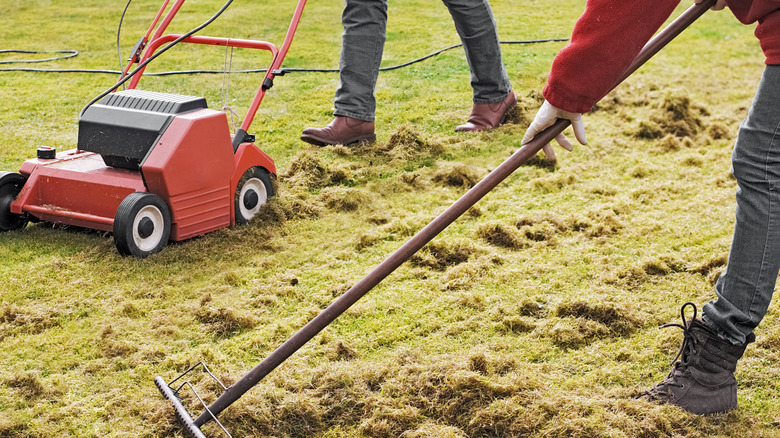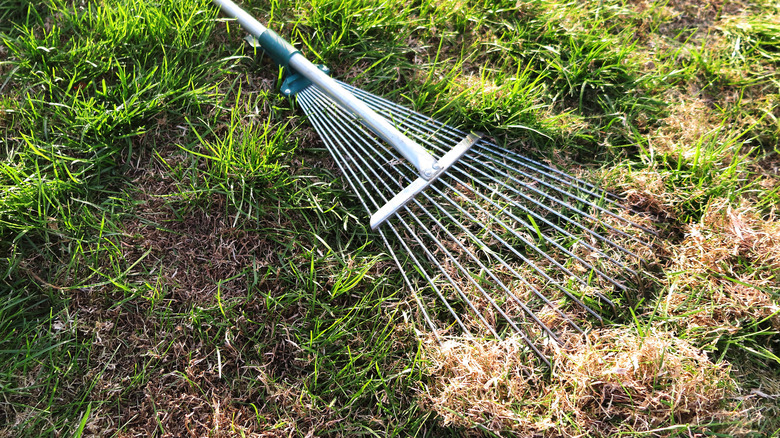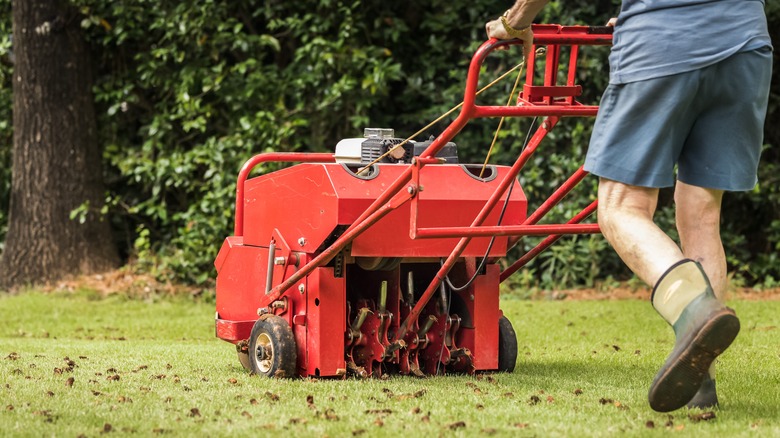The Most Important Lawn Care Task You Must Do Right After Your First Mow Of The Spring
Before you know it, warmer days will be here, and your backyard will be calling for your attention. You probably have a running list of projects to get to, but one item that's often forgotten is getting rid of thatch on your lawn. Although this does not sound terribly exciting, it is a crucial step in spring lawn care because it allows new grass shoots to thrive when growing conditions are right — and is a natural way to keep your lawn green.
If you're wondering what thatch is, it's the thick layer of mostly-dead grass and shoots that form at the base where the stems meet the roots and the soil. An easy way to identify it is if your lawn is green on top and brown at the bottom. The undesirable mat of dead grass is caused by applying too much water to your lawn or overdoing it with fertilizer, or mowing your grass on a setting that's too high. It is best to get rid of it in early spring because it tends to block water and nutrients from reaching the soil and can cause your grass to thin out and die.
With all that said, a good time to check for thatch is right after your first mow of the season. After cutting the top green growth of grass with your lawnmower, observe if your lawn looks brown or dead underneath. If there's more than an inch of brown material above the soil surface, that's a good sign you need to dethatch your lawn.
Dethatch your lawn with a rake after mowing the grass
Dethatching is the process of removing the thick layer of thatch which allows air, water, and nutrients to reach your grass again. The best tool for the job is what's called a thatching rake, which you can find at most garden stores. Some of them look similar to a leaf rake and have curved sharp blades at the ends that dig up dead grass as you clear debris from the ground. Be mindful that it will take some strength when you apply pressure on the rake to dig deep enough to penetrate the thatch and loosen it. If you're dethatching a large lawn, a power dethatcher might come in handy, which you usually can rent from most hardware stores if you don't want to purchase one.
There are ways to know when it's time to dethatch your lawn — early spring is a popular time in four-season climates, because the process allows new grass growth to thrive at its growing peak. Your lawn will look a little ragged and somewhat of a mess after you're done, but rest assured, it is supposed to look this way. In fact, dethatching sets the groundwork to reseed and aerate your lawn, which helps prevent dead organic material from forming in the first place.
Aerate your lawn to prevent thatch from growing back
Aerating your lawn is crucial to avoiding thatch problems in the future, because it allows air, water, and nutrients to reach the ground. It is the practice of making holes in your lawn and loosening the soil, and is often done right after dethatching to help the surrounding grass thrive again and avoid further dead grass buildup. Also, reseeding after aerating can help fill in any bare spots left in your lawn from thatching. Usually, all three tasks (dethatching, aeration, reseeding) are done in steps.
Avoiding thatch altogether might seem unrealistic, but it is somewhat possible by regularly aerating your lawn and taking thoughtful actions when caring for your grass. You can start by not overusing fungicides and taking it easy on the fertilizer, which can cause grass to grow too quickly. As far as watering goes, aim to water your lawn deeply, but less frequently, because overwatering causes thatch. Best of luck!


